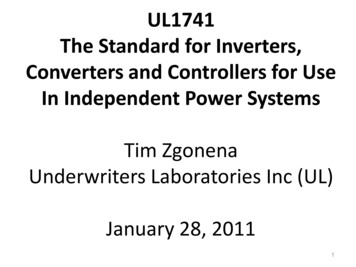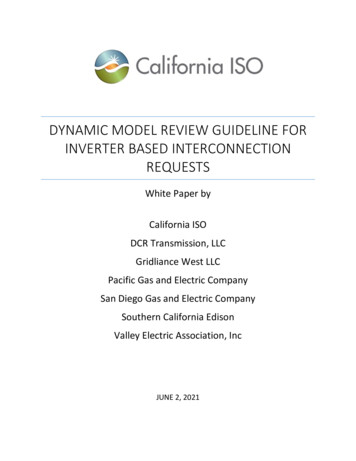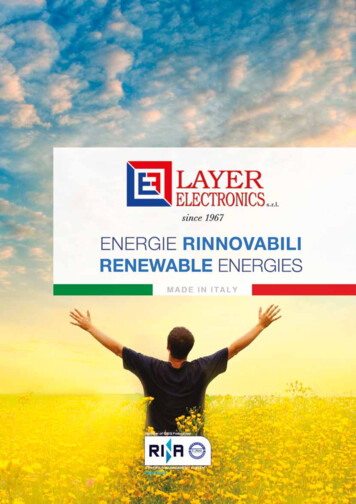
Transcription
UL1741The Standard for Inverters,Converters and Controllers for UseIn Independent Power SystemsTim ZgonenaUnderwriters Laboratories Inc (UL)January 28, 20111
UL1741 is a product safetystandard and it is notwritten specifically forreliability, but it includesconstruction requirementsand tests that can lead tomore reliable products2
UL 1741 Covers the Following Typesof DG products: Photovoltaics, PVFuel CellsMicro-turbinesWind and Hydro TurbinesEngine Generator Set Interconnect Controllers3
Most UL Equipment SafetyStandards Evaluate Electrical HazardsFire HazardsMechanical HazardsVerification of electrical ratings These hazards are evaluated underMFR defined normal conditions andforeseeable abnormal conditions
Construction Requirements Components are required to have appropriateelectrical ratings for their application andoperation. Enclosures (electrical and environmental) Electrical Spacings are required to account for:– Pollution degree– Over Voltage Category– Polymeric material long term electrical andmechanical characteristics.5
Fire Hazards Verification of normal operating temperatures Acceptable operation of product under shortcircuit and overload conditions Compliance Criteria: Under no circumstancesshall a product emit sparks, flames or moltenmetal6
Temperature Testing Attempt to identify worst case electrical andenvironmental operating conditions withinmfr rated operating parameters.– Max and min input and output voltage– Max operating ambient– Before and after thermal derating– Charging or discharging energy storage devices7
Temperature Test Some component worst case operating conditionswill be different than other component worst caseoperating conditions so we will record the worstcase temperatures for the component and definethe operating conditions. Testing used to characterize the power de-ratingcurve of the unit under test. Curve is tested at several points to ensure that theunit does not exceed any temperature limits orbecome a fire hazard at any point.8
Markings, Ratings and Instructions Product safety and reliability are highly likely todecrease when products are installed andoperated outside of the manufacturer specifiedelectrical, mechanical and environmental ratings– Max input voltage– Max input short circuit rating– Max operating ambient– Max output over current protection rating– Max reverse current– Etc.9
UL 1741 is a Unique Standard Performance Issues associated with the gridinteractive operation of the DG groducts areimportant safety issues. This is unlike many other product categoriescovered by UL standard which normallyconcentrate on electric shock and fire hazardsonly.10
Software Considerations
Software Considerations of UL 1741 Software is viewed as the main criticalcomponent of a utility interactive inverter asthe software often controls most of the utilityinteraction of the inverter.12
Software Considerations of UL 1741 One version of software and critical hardwareare evaluated during the utility interactivetesting but is viewed as a component of theinverter and identified by software versionnumber and correlated by a checksum or CRCvalue.13
Software Considerations of UL 1741 A software investigation can be conducted byUL to evaluate some safety critical functions ofthe software to the UL 1998 standard – Thestandard for software in programmablecomponents.– GFDI– Over-temperature protection– Non-isolated / transformerless inverter protection14
DefinitionFunctional safety is part of the overall safety thatdepends on a system or equipment operatingcorrectly in response to its input(s).Example (Over-current Protection)“Older” Technologyvs.“Newer” TechnologyMicroprocessorFuseLoadWhat Is Functional SafetyLoad
“Old” versus “New” UL Requirements Electrical Safety (Traditional UL Listing) Electromechanical Safety / Reliability of Performance Aspects(Traditional UL Listing Some Aspects of Functional Safety) Electronic Safety / Reliability (“New” Technologies)– Software– EMC (Dual purpose use to satisfy performance and FS)– Component Reliability (eg. No Single Points of Failure)– System ReliabilityWhat Is Functional Safety
Utility Compatibility andInterconnection Concerns
Conducting Utility Interactive Tests The Utility Interactive Tests are conducted aspart of a sequence as outlined in IEEE 1547. The test sequence must be completedsuccessfully with a single sample. These tests are conducted to ensure that theInterconnect Integrity Tests do not result inany adverse affect on the unit’s ability toaccurately respond to abnormal gridconditions.18
IEEE 1547 Grid InterconnectIntegrity Testing Protection From Electromagnetic Interferenceor EMI Test as outlined in the standard IEEEC37.90.2. The influence of EMI shall not resultin a change in state of the interconnectionsystem. Surge Withstand Performance (line surges) asoutlined in the standard IEEE C62.41.219
Certification and Performance Certification and theProduct Development CycleOne timeEvaluation of hand pickedor hand built “Golden Samples”Follow Up Not rtificationDesignConsulting PreliminaryAnd Training uctionWithout Follow Upmodules, componentand materials canchange and invalidateperformance n, Manufacturing Product failureProduct auditsInvestigationFollow UpInspection &Testing
UL1741 Listing Certifications The UL1741/IEEE1547 combination ofrequirements are being used to evaluate gridtied DG products for both electrical safety andutility interconnection. This certification provides a stabile platformfor the CEC Inverter Efficiency program. It could also be leveraged for adjunct productreliability evaluations.21
Questions?Tim ZgonenaPrincipal EngineerUnderwriters Laboratories, Inc.
IEEE 1547 Grid Interconnect Integrity Testing Protection From Electromagnetic Interference or EMI Test as outlined in the standard IEEE C37.90.2. The influence of EMI shall not result in a change in state of the interconnection system. Surge Withstand Performance (line surges) as o










